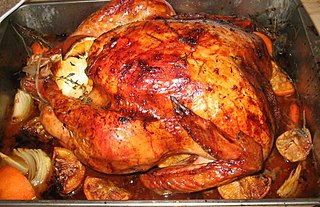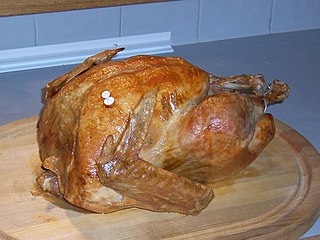
A sausage is a type of meat product usually made from ground meat—often pork, beef, or poultry—along with salt, spices and other flavourings. Other ingredients, such as grains or breadcrumbs, may be included as fillers or extenders.

A sausage roll is a savoury dish, popular in current and former Commonwealth nations, consisting of sausage meat wrapped in puff pastry. Although variations are known throughout Europe and in other regions, the sausage roll is most closely associated with British cuisine.

In the United States, pigs in a blanket are small hot dogs or other sausages individually wrapped in pastry, commonly served as an appetizer.

A blood sausage also known as a blutwurst sausage, is a sausage filled with blood that is cooked or dried and mixed with a filler until it is thick enough to solidify when cooled. Most commonly, the blood of pigs, sheep, lamb, cow, chicken, or goose is used.

Offal, also called variety meats, pluck or organ meats, is the internal organs of a butchered animal. The word does not refer to a particular list of edible organs, and these lists of organs vary with culture and region, but usually exclude skeletal muscle. Offal may also refer to the by-products of milled grains, such as corn or wheat.

Toad in the hole is a traditional British dish consisting of sausages in Yorkshire pudding batter, usually served with onion gravy and vegetables. Historically, the dish has also been prepared using other meats, such as rump steak and lamb's kidney. In the 21st century, vegetarian and vegan versions have appeared.

Danish cuisine originated from the peasant population's own local produce and was enhanced by cooking techniques developed in the late 19th century and the wider availability of goods during and after the Industrial Revolution. Open sandwiches, known as smørrebrød, which in their basic form are the usual fare for lunch, can be considered a national speciality when prepared and garnished with a variety of ingredients. Hot meals are typically prepared with meat or fish. Substantial meat and fish dishes includes flæskesteg and kogt torsk with mustard sauce and trimmings. Ground meats became widespread during the industrial revolution and traditional dishes that are still popular include frikadeller, karbonader and medisterpølse. Denmark is known for its Carlsberg and Tuborg beers and for its akvavit and bitters, but amongst the Danes themselves imported wine has gained steadily in popularity since the 1960s.

Rice pudding is a dish made from rice mixed with water or milk and commonly other ingredients such as sweeteners, spices, flavourings and sometimes eggs.

A chipolata is a type of fresh sausage, likely created in France. Sausages by that name appear in the 1903 edition of Escoffier's Le guide culinaire. Chipolatas are often prepared as a relatively thin and short sausage.

Christmas dinner is a meal traditionally eaten at Christmas. This meal can take place any time from the evening of Christmas Eve to the evening of Christmas Day itself. The meals are often particularly rich and substantial, in the tradition of the Christian feast day celebration, and form a significant part of gatherings held to celebrate the arrival of Christmastide. In many cases, there is a ritual element to the meal related to the religious celebration, such as the saying of grace.

Devils on horseback are a hot appetizer or small savoury dish of dried fruit stuffed with such ingredients as cheese or nuts, wrapped in bacon, prosciutto or pancetta. The traditional form of the dish is made with a pitted date and bacon, but prunes are also used, usually steeped in brandy or some other liqueur. These are then fried or baked in the oven and quite often served on toast, with chutney and mustard.

Risalamande is a traditional Danish dessert served at Christmas dinner and julefrokost. It is made of rice pudding mixed with whipped cream, sugar, vanilla, and chopped almonds. It is served cold with either warm or cold cherry sauce (kirsebærsovs).

Turkey meat, commonly referred to as just turkey, is the meat from turkeys, typically domesticated turkeys, but also wild turkeys. It is a popular poultry dish, especially in North America and the United Kingdom, where it is traditionally consumed as part of culturally significant events such as Thanksgiving and Christmas respectively, as well as in standard cuisine.

Black pudding is a distinct national type of blood sausage originating in the United Kingdom and Ireland. It is made from pork or occasionally beef blood, with pork fat or beef suet, and a cereal, usually oatmeal, oat groats, or barley groats. The high proportion of cereal, along with the use of certain herbs such as pennyroyal, serves to distinguish black pudding from blood sausages eaten in other parts of the world.

Pea soup or split pea soup is soup made typically from dried peas, such as the split pea. It is, with variations, a part of the cuisine of many cultures. It is most often greyish-green or yellow in color depending on the regional variety of peas used; all are cultivars of Pisum sativum.

Bacon-wrapped foods are foods that are prepared by being covered in bacon. They may be baked, fried, or grilled. Popular bacon-wrapped dishes include angels on horseback, devils on horseback, and pigs in blankets. Bacon has long been used for barding roasts, especially game birds.





















